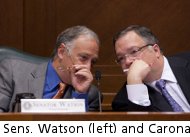6/1/2009
Traffic Camera Lobbyists Score Big Win in Texas LegislatureBonanza for traffic camera companies as Texas legislature expands use of automated ticketing machines.

The companies that operate traffic enforcement cameras scored total victory in the Texas legislature late Saturday as key lawmakers not only ditched a plan to sunset the use of red light cameras and lengthen yellow warning times at intersections, but they also approved a number of brand new opportunities for automated ticketing firms. The ten members of the Texas Department of Transportation (TxDOT) reauthorization conference committee filed the final legislative text for House Bill 300. It cannot now be changed unless either the House or Senate votes to reject the 532-page bill in its entirety. Update: The legislature adjourned without passing this bill. The entire issue will be reconsidered next session.
Senator John Carona (R-Dallas) championed the cause of the automated ticketing companies by using a Senate-supported gasoline tax increase provision as leverage to convince tax-averse House members to drop their ban on red light cameras and the provision requiring longer yellow times. Carona had threatened to give local jurisdictions the authority to increase the fuel tax at a local level to boost government spending, as long as the increase was approved by referendum. The House had introduced the longer yellow provision as a safety measure in response to a Texas Transportation Institute (TTI) study that documented a 40 percent decrease in collisions after testing the benefits of increasing the yellow (view study), but photo enforcement companies and local jurisdictions opposed the provision because it would have reduced ticket revenue.
The only accommodation given to red light camera opponents in the final conference report was a provision allowing motorists to take an "intersection safety course" to avoid paying the $75 civil photo ticket. Local jurisdictions with camera programs do not have to offer such courses, and if they do, cities could legally charge more than the $75 ticket fee for the cost of the course. It is unclear why either a local jurisdiction or a motorist would seek this option.
The bill also recodifies provisions designed to make it a crime punishable by a $100 fine to have a license plate that cannot be read by an automated ticketing machine. This helps as the legislation creates a new "video billing" option offered by several automated ticketing companies for the purpose of collecting revenue on toll roads. The bill also encourages increasing the number of toll roads -- and consequently more video-based toll collection and enforcement systems -- by allowing "non-compete" contracts that effectively forbid improvements on free roads within a four-mile radius of any toll road.
Carona also succeeded in introducing a new high-occupancy vehicle (HOV) lane automated ticketing program that will mail $100 photo tickets to the owner of any vehicle accused of being in a carpool lane without the required number of passengers. It is unclear what automated technology will be used to peer into vehicles to count the number of occupants. Another TTI study found that safety would be improved if HOV lanes were eliminated. In Dallas, HOV lanes increased the number of injury accidents by up to 188 percent (view study).
Senators Carona and Kirk Watson (D-Austin) opposed the red light camera ban at every step of the process. Over the years, both senators have been richly rewarded by the lobbyists who support photo enforcement. For example, the firm Linebarger, Goggan, Blair and Sampson performs collection services for photo tickets and has handed Carona $24,500 in campaign cash and $11,912 to Watson. Watson took another $8000 from the lobbyists for American Traffic Solutions (ATS) and Redflex -- Hugo Berlanga and Michael Warner.
A controversial automated license plate surveillance program was dropped at the last minute. The final bill also dropped an amendment clarifying that an existing ban on municipalities operating speed cameras applies to county governments and TxDOT.
Relevant excerpts from the final conference report appear in a 900k PDF file at the source link below.


